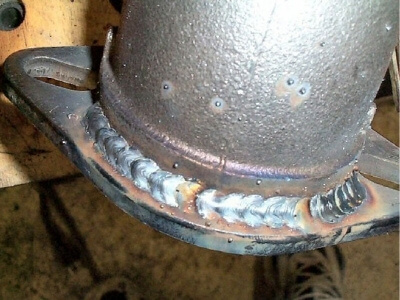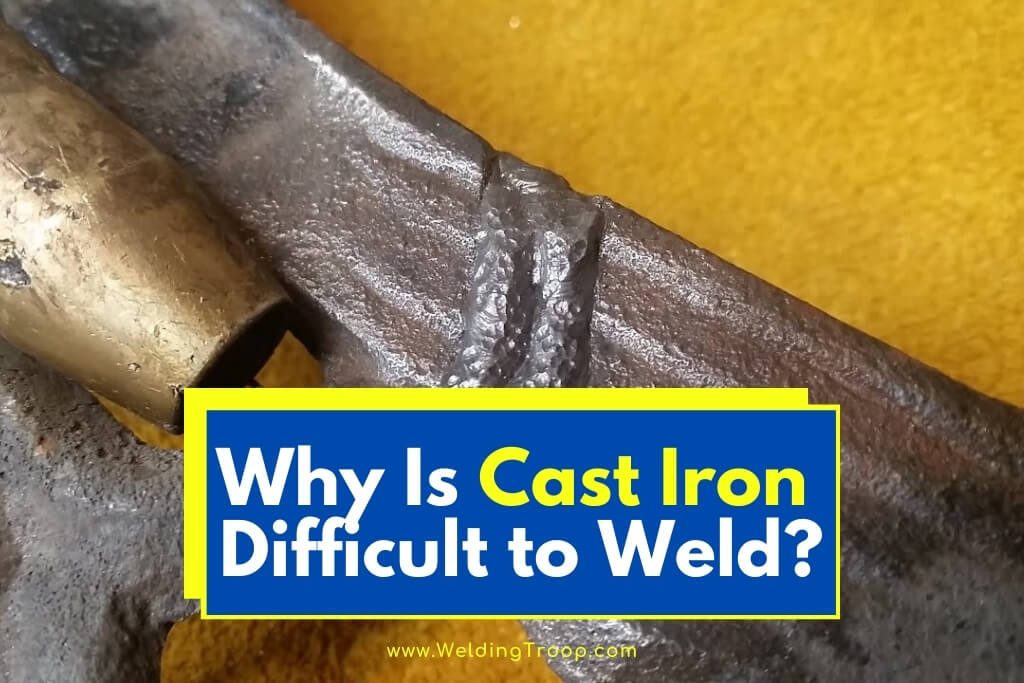Have you ever wondered why it is hard to weld cast iron and what are cast iron welding rod numbers?
When you’re a welder, you are already familiar with many different types of metal, but what’s the deal with cast iron? Cast iron melts easily, so why is it so difficult to work with when you weld?
Why is cast iron so difficult to weld? The bottom line is that cast iron has a very high carbon content – roughly 10 times the amount found in most other steels. This makes it prone to cracking and breaking because it is so brittle.
This is especially true over time because the more heat it receives, the more stress the iron has to tolerate, and it get weaker and weaker each time.
Table of Contents
Introduction
Many people assume that you cannot weld cast iron, but this isn’t entirely true. In fact, you can weld something made out of cast iron, but you have to know how to do it correctly.
Cast iron has a carbon content of 2% to 4%, which is exceedingly high when compared to other metals. Because of this, cast iron tends to be very brittle and often results in flakes of graphite falling off.
This is especially true when you’re using gray cast iron, which is the most common type of cast iron used in welding.

Many times, welders use cast iron when making repairs to castings and not when joining castings to other pieces.
These repairs can be either in the foundry where the castings are actually produced or they are used to repair any defects that are in the casting and which were discovered after the part is machined.
If cast iron parts are mis-machined, for example, when holes are drilled into the wrong location, you may have to do some repair welding such as this.
The high carbon content in cast iron also means that if you heat and cool it too quickly, it can become overly brittle and crack.
This is especially true when you use a filler rod that has a low carbon steel content.
In addition, this tends to be brittle can result in uneven expansion while you’re welding, which means cracks can form even a long distance from the place where you’re welding.
It is also sometimes difficult to keep cast iron surfaces aligned correctly, even when they are machined properly, due to the fact that they often have tight dimensional tolerances.
What Is the Best Method to Weld Cast Iron?
MIG welding can be a suitable method for welding cast iron, but it requires careful handling due to the high carbon content of cast iron, which can cause cracking during the welding process. However, with the use of specialized flux-cored electrode wires, such as nickel-based wires like ERNiFe-CI or ERNi55, MIG welding can produce strong and ductile welds on cast iron.
To ensure a successful MIG weld, it is recommended to preheat the welding area, control the expansion and contraction of the cast iron, and check the MIG welder’s temperature, keeping in mind the high carbon content of cast iron.
Stick/arc welding and gas welding are other methods that can be used to weld cast iron but may require different welding rods.
What Temperature Do You Weld Cast Iron?
When MIG welding cast iron without preheating, the temperature should be about 100°F (38°C). However, bear in mind that welding cast iron requires special care due to its high carbon content.
Before beginning, it is important to check the MIG welder’s temperature. If the temperature is too high or too low, cast iron may heat up fast and cause damage
Why Is Welding of Chilled Cast Iron Not Recommended?
Welding chilled cast iron is not recommended because it contains high carbon and silicon, which makes it brittle and prone to cracking. Additionally, the abrupt temperature changes that occur during the welding process can cause thermal shock and lead to further cracking.
Instead of welding, it is recommended to use mechanical methods such as brazing, riveting, or bolting to repair or join chilled cast iron components.
Can You Weld Cast Iron Anyway?
Once again, you can weld cast iron in many circumstances, but you have to first follow a few basic rules so that the project doesn’t literally fall apart on you.
One way to accomplish this is to preheat the entire piece of cast iron until it is bright cherry-red in color, then allow it to cool slowly and completely by wrapping it in rock wool.
One thing to remember, however, is that cast iron often cracks even under the best of circumstances, and the problem usually starts when the cast iron either snaps under the stress or merely breaks into several pieces, but thankfully you can have better luck if you follow some simple tips.
When welding cast iron, you should never get above 1450 degrees Fahrenheit, because this is the temperature that causes cracking and breaking to occur.
The arc is able to heat the castings even above this temperature, but you should never use this temperature for long periods of time.
In addition, there are two main processes that work best when working with cast iron, and they are as follows.
Welding Cast Iron With Preheat
and lots of it. With this method, you’ll want to preheat the cast iron before you start to weld, including the area around the weld.
If you can heat the entire casting, this is always better, and you should aim for temperatures of 500 to 1200 degrees Fahrenheit.
Never go over 1400 degrees Fahrenheit, and always use a slow, uniform motion to preheat the part.
There will be less stress if you weld using a low current, and keep in mind that you may have to restrict the welds to small segments so that residual stresses won’t cause cracking – the segments should be no more than one inch long, in other words.
Once welding is complete, you should allow the part to cool very slowly. While it’s cooling off, wrap the casting in a blanket that’s insulated or try burying it in dry sand.
Both of these techniques will help the cooling-down process take place in a slow manner, which is what you want.
Welding Cast Iron Without Preheat
Some circumstances require the weld to take place without preheating, and the main tip here is that the part has to be kept cool but never cold.
Try raising the casting temperature to 100 degrees Fahrenheit, but never heat the casting until it is too hot to place your bare hand on it – you should always be able to do that without burning yourself.
If the part itself is on an engine, you might be able to run it for a few minutes to get it up to that 100-degree temperature.
Just like in the preheat method, you should aim for short welds roughly one inch in length.
Peening after you weld is also important. Also, you should never cool it off too quickly, so no cooling with compressed air or with water.
With the non-preheat method, you should fill in any craters that result and deposit the beads in the same direction – preferably with the ends of the parallel beads not lined up with one another.
Cast Iron Welding Rod Numbers
There are two common types of Cast iron Welding Rod, Ferro-Nickel and Pure Nickel. Ferro-Nickel are typically 53% Steel and 47% Nickel.
Ferro-Nickel Rods are cheaper than pure Nickel and are ideal for welding Cast Iron to Steel. Pure Nickel will produce a softer, more malleable weld deposit.
| Options Nr. | Welding rod for cast iron |
|---|---|
| 1 | Nickel Allow Rods |
| 2 | Cast Iron Covered Rods |
| 3 | Steel Rods |
Before you continue reading, here is an article we wrote about selecting a welding rod for cast iron
A Few Other Helpful Tips
If your casting needs to be water-tight and you notice any cracks next to the weld, you can use a sealing compound to take care of the problem.
Remember, you can weld cast iron with preheat or without preheat, but only follow one of these techniques and never change up what you’re doing in the middle of the process.
Once you choose one of these processes, you’ll either have a very hot situation or a cool (not cold) one, and it’s easy to understand why you should choose one or the other.
As long as you are familiar with cast iron and how to work with it, you’ll increase the odds of being successful at the task.
Here are some of my favorite tools & equipment´s
Thank you for reading this article. I hope it helps you find the most recent and accurate information for your welding project. Here are some tools that I use daily and hope you´ll also find helpful.
There are affiliate links, so if you do decide to use any of them, I´ll earn a small commission. But in all honesty, these are the exact tools that I use and recommend to everyone, even my own family. (NO CRAP)
To see all my of most up-to-date recommendations, check out this resource that I made for you!


